Simplify Auxiliary Data Ingestion for Smarter and Personalized Engagement With MoEngage
Auxiliary Data empowers you to effortlessly ingest supplemental data to drive effective personalization and targeted engagement.
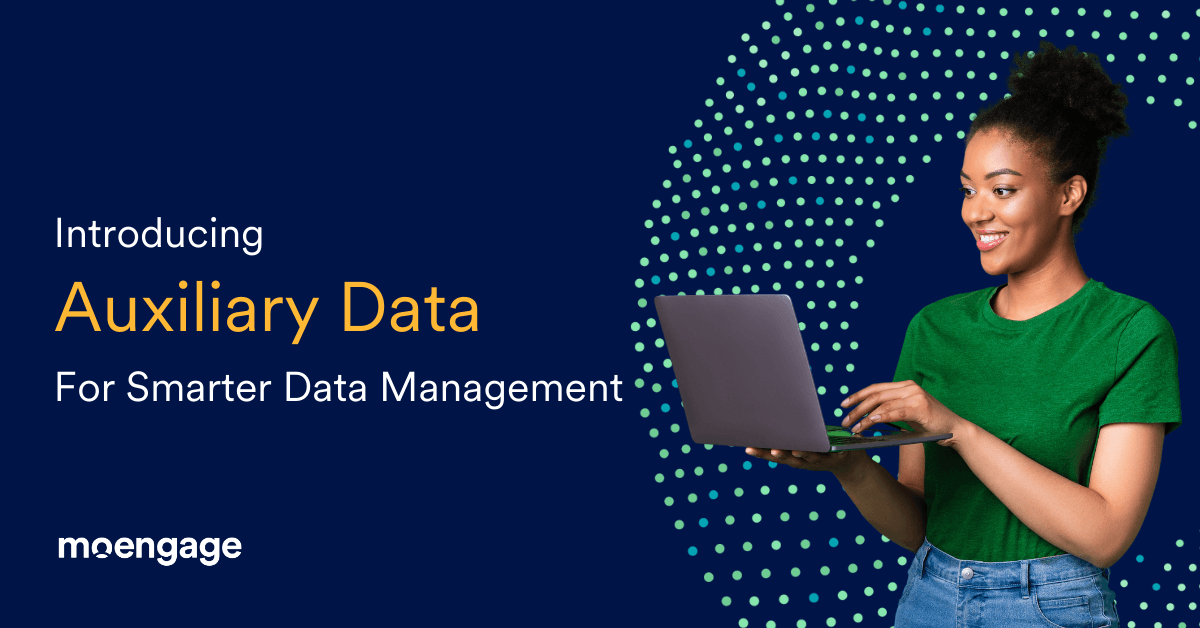
Reading Time: 7 minutes
Do you want to introduce a reward program on your OTT platform where customers can accumulate points for the hours they’ve streamed content, and you communicate their rewards via push notifications?
Do you want to run a contest on your Shopping website where customers can submit entries, earn reward points, and win exciting prizes, and you want them to earn the prizes right away?
Or maybe you want to automate your regular weekly campaigns, suggesting the best playlists for various top genres?
Achieving all the above requires you to upload supplemental data into your Engagement platform, leading to data complexities.
If you’re looking for a solution to utilize additional data for your engagement efforts, you’re at the right place!
What Is MoEngage’s Auxiliary Data All About?
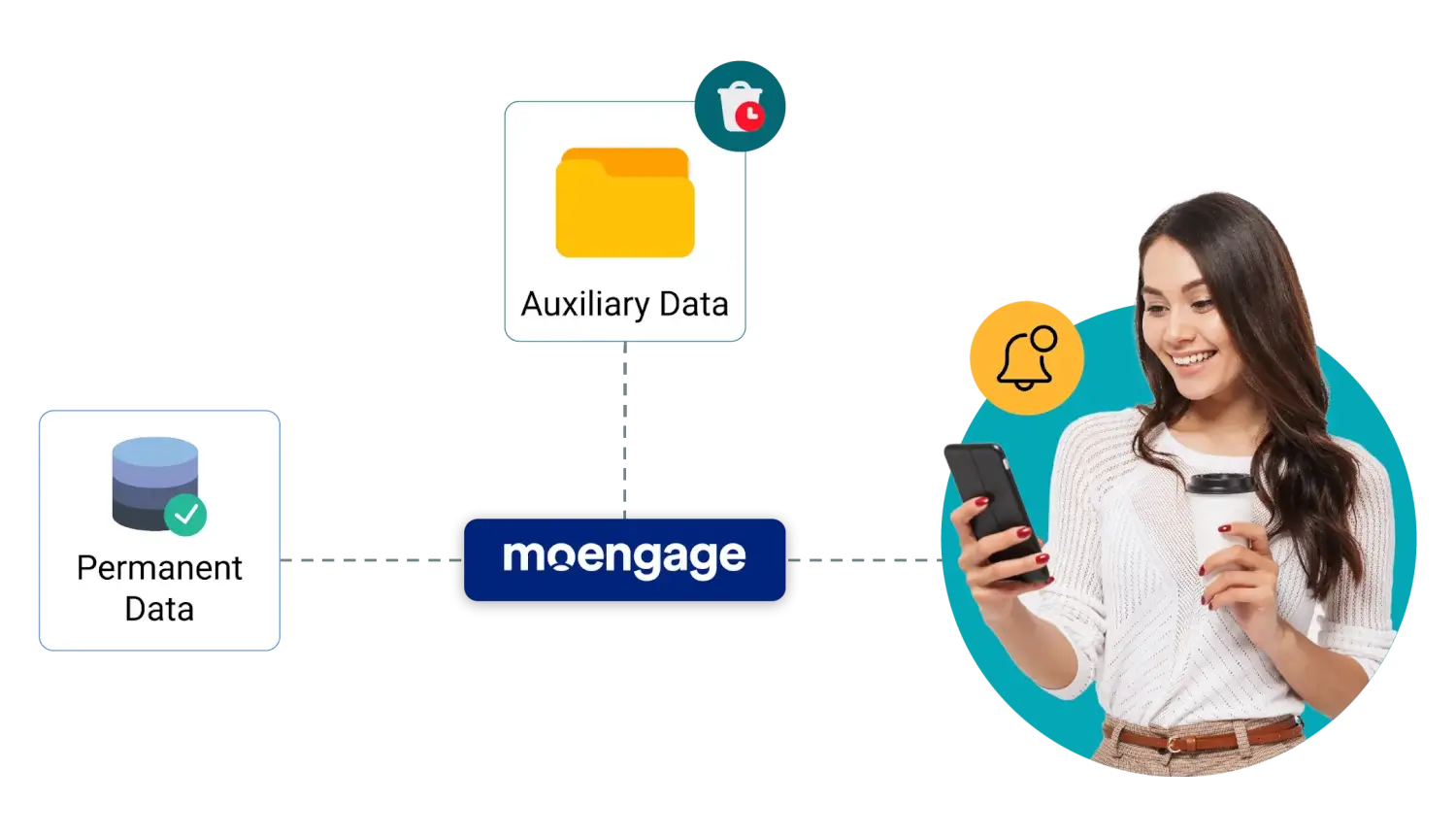
MoEngage’s latest feature release, Auxiliary Data, enables marketers like yourself to seamlessly upload supplemental data and use it to drive dynamic personalization.
With a user-friendly interface, you can quickly ingest additional data while keeping it separate from primary data. This helps you prevent data clutter that arises due to redundant attributes and variations, ensures data clarity, and minimizes confusion.
You can retain this data on MoEngage for as long as necessary! This can be for short-term use to support limited-period campaigns, with data being disposed of automatically afterward. Or, it can be for extended durations, even indefinitely, to drive personalization and support long-term campaigns.
The streamlined data management introduced by MoEngage gives your team the flexibility to drive impactful engagement at scale using supplemental data.
How Do You Know You Need Auxiliary Data?
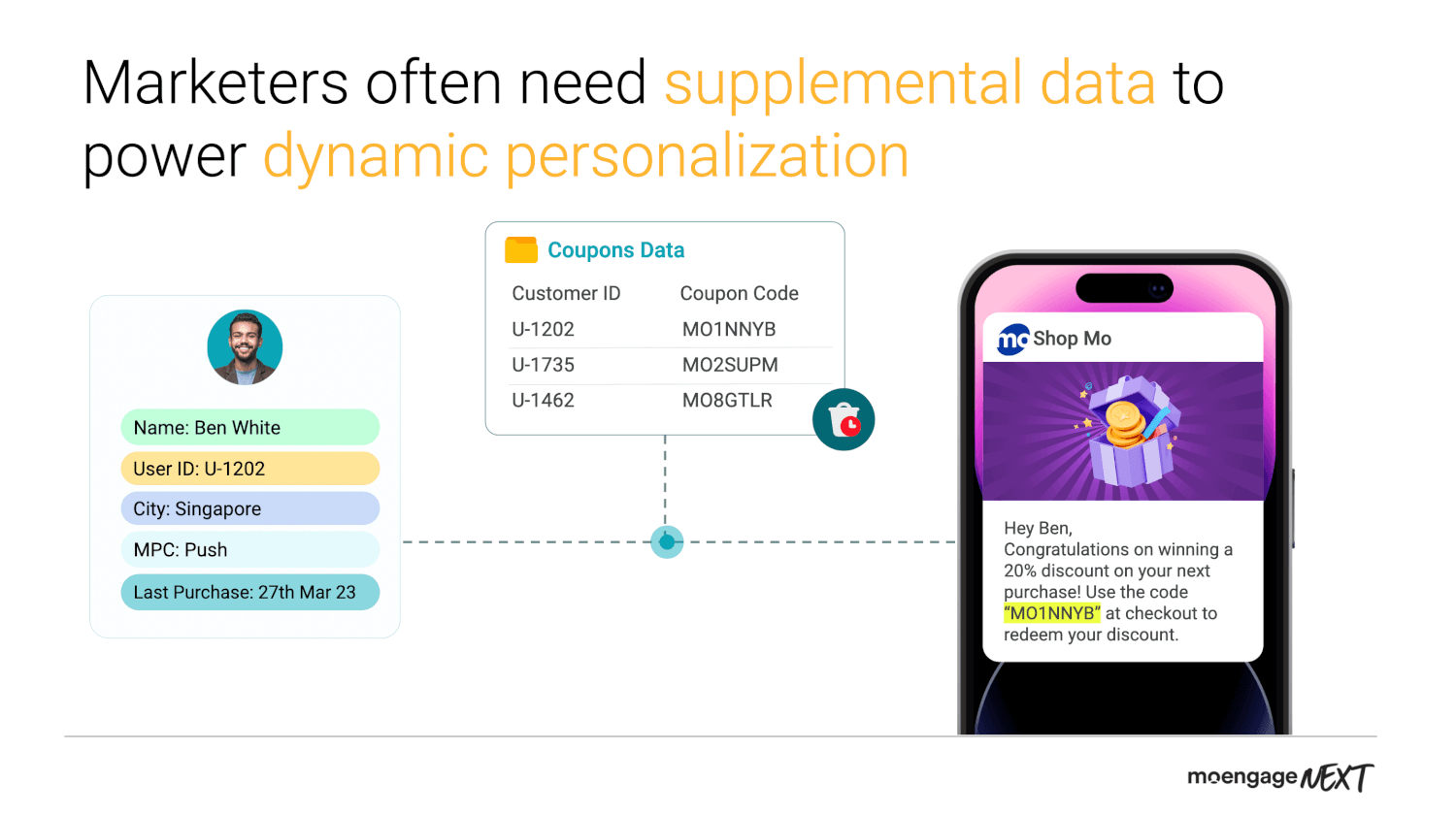
As a marketer, analyst, or product manager, chances are you’ve been in a situation where you wanted to upload additional data that might be short-lived, or it is dynamic and changes very frequently, to your Engagement platform without depending on your data or engineering teams.
1. Your current Engagement platform does not support the upload of additional data
Marketers often want to upload supplementary data (separate from primary data) to achieve various goals such as advanced personalization, hyper-relevant engagement, or data enrichment.
But most often, their current platform doesn’t enable you to do so, forcing you to upload the additional data via primary data models instead.
2. You have a lot of data clutter, leading to confusion in decision-making
The accumulation of redundant attributes and variations is a common sight when auxiliary data is stored using primary data models.
These differences arise due to different approaches used by various teams when they organize supplementary data. It leads to a chaotic data structure, causing confusion and limiting teams from maximizing their data’s full potential.
3. You find it tedious to clean up data
Maintaining data gets too complex when additional data is ingested and stored via primary data models. Regular cleanups are required to remove outdated information, which demands tedious efforts and active monitoring.
4. You have limited flexibility in leveraging supplementary data
The hurdles and challenges associated with managing auxiliary data as primary data models often create barriers, restricting your flexibility and scalability regarding leveraging data for dynamic personalization.
5. You need to change existing processes and workflows
Generally, data teams are in charge of analyzing data and creating relevant segments. The marketing team then uses this to run campaigns.
But understanding the segments to run hyper-personalized campaigns requires comprehensive documentation, without which crucial information cannot be uploaded and used in your Engagement platform.
To seamlessly achieve this, you end up implementing changes in organizational workflows and processes involving multiple functions.
What Are the Benefits of Using MoEngage’s Auxiliary Data?
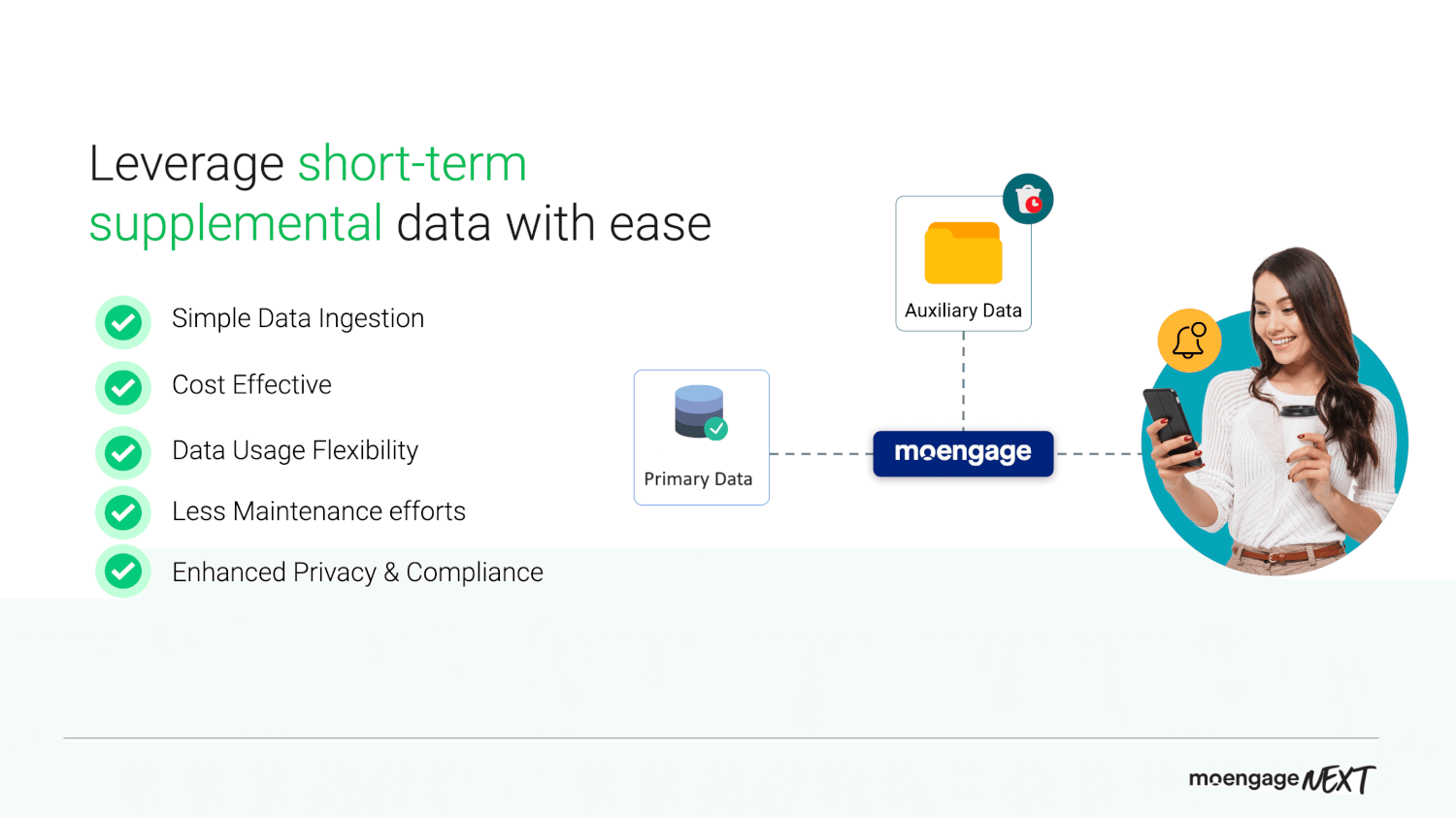
Your brand needs an easy-to-use solution that enables your marketing team to seamlessly upload supplemental data and leverage it to build personalized experiences via hyper-relevant campaigns.
With Auxiliary Data, you can:
1. Ingest supplementary data effortlessly
Through Auxiliary Data, brands can effortlessly incorporate supplemental data into MoEngage.
This data can be used for varied use cases, from enhancing personalization and targeted engagement to triggering campaigns and enriching data.
2. Simplify data management
Thanks to a structured approach to integrating auxiliary data independently of primary data models, you can prevent clutter that arises due to duplicate attributes and variations.
3. Reduce data maintenance efforts
A specialized framework for auxiliary data ingestion, combined with automated data disposal, allows brands to sidestep the challenges of merging short-term data with permanent structures.
This simplifies maintenance, eliminates the need for constant oversight, and reduces cleanup efforts by ensuring only relevant data is stored.
4. Achieve additional data flexibly
With the freedom to upload additional data, teams can seamlessly incorporate vital supplementary information for diverse use cases without altering primary data or introducing needless attributes.
This provides the flexibility to harness data effectively while preserving the integrity of the original data structure and preventing clutter.
5. Ensure organizational workflows and processes remain unchanged
Large organizations can maintain their current organizational workflow thanks to the streamlined process of effortlessly uploading auxiliary data to your Engagement platform.
Thanks to Auxiliary Data, your data teams can continue their analysis and enable marketing teams with the necessary data to drive hyper-personalized engagement.
What Is the Impact of Using Auxiliary Data?
1. Enhance campaign performance metrics
Marketers can improve engagement metrics, such as click-through rates (CTR), email open rates, and overall campaign interaction through hyper-relevant campaigns with personalized messaging.
2. Improve customer experience
You can drive higher customer satisfaction and loyalty scores by building personalized and memorable customer experiences on and off your platform.
3. Reduce resource wastage
Auxiliary Data’s streamlined data management and reduced maintenance efforts prevent unnecessary resource wastage, allowing you to allocate resources more efficiently and strategically.
4. Improve decision-making processes
Analysts and product owners can accelerate insight gathering by looking at enriched data from auxiliary sources, leading to quicker and more informed decision-making processes.
Examples of Auxiliary Data
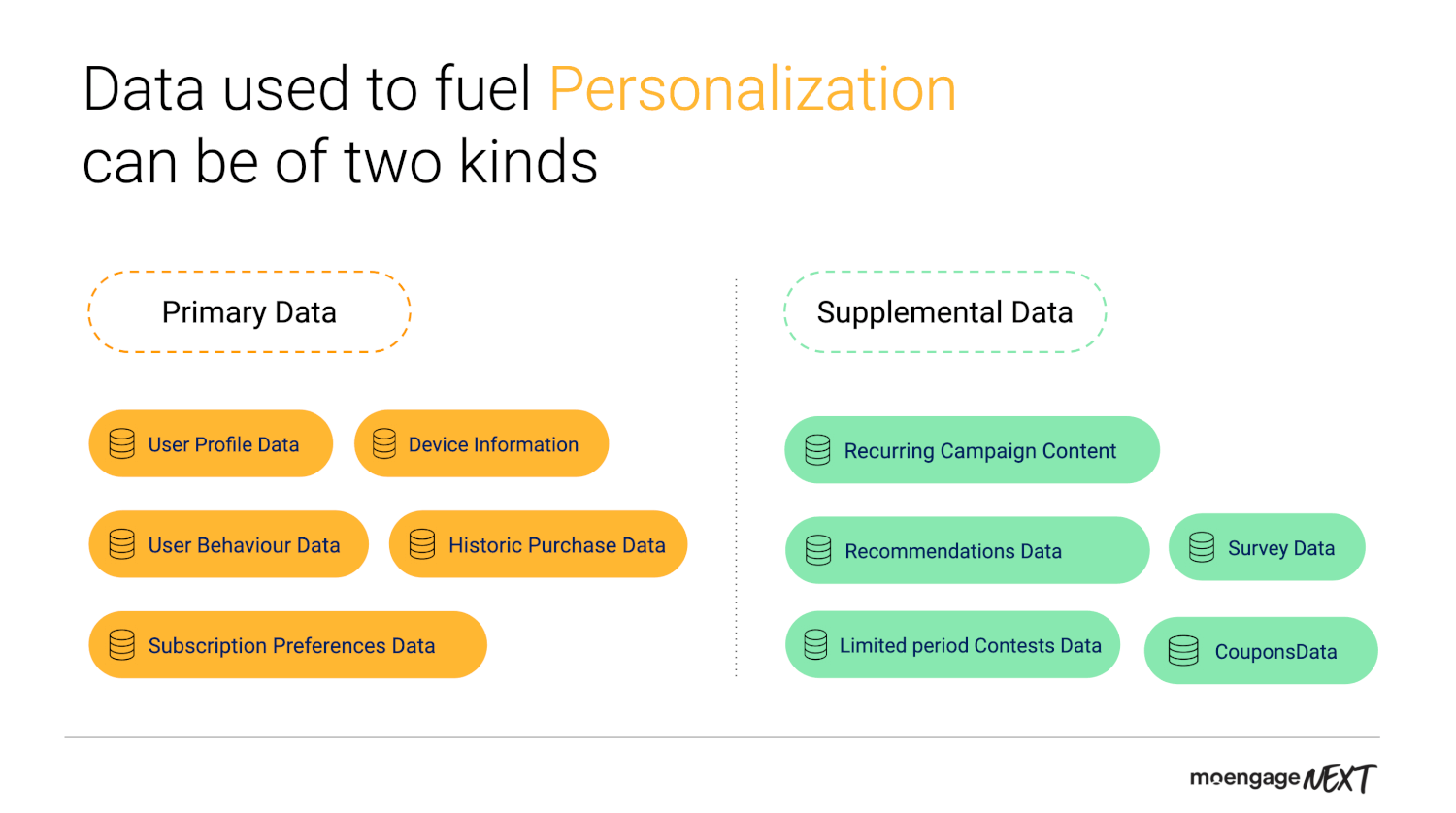
Here are a few examples of the different additional data that brands upload to MoEngage’s Auxiliary Data and utilize for their engagement campaigns:
- Survey/feedback data: Collected feedback and ratings to improve your products or services.
- Product recommendations: Custom personalized recommendations for specific segments and cohorts.
- Recurring campaign content: Content/copies and dynamic variables that can be used in recurring campaigns
- Limited-time loyalty/reward points: Earned and redeemed loyalty points to share relevant rewards.
- Webinar/event/contest data: Interest of registrants or attendees for tailored engagement and follow-ups.
- Campaign-specific data: Storing content for recurring campaigns or audience-targeting data provided by centralized teams.
- Offline engagement data: Upload engagement data from offline marketing campaigns, physical stores, and retail outlets.
Apart from these, some brands, especially in the BFSI and Healthcare industries, may also upload short-lived confidential data to MoEngage, such as PII, and use that data to personalize communication with their customers.
How Can Brands Use Auxiliary Data?
Brands can leverage Auxiliary Data to drive multiple use cases (not limited to only the following):
- Personalized campaigns: Seamlessly upload supplemental data to drive personalized campaigns, ensuring relevant messaging.
- Targeted Engagement: Effortlessly drive targeted engagement by quickly uploading segments through Auxiliary Data using files.
- Auto-refresh recurring campaigns: Upload campaign content that can be periodically auto-triggered in recurring campaigns.
- Bring your own recommendations: Upload your own tailored product or content recommendations.
- Legacy data ingestion: Organizations using legacy platforms can efficiently incorporate data by uploading files and simplifying engagement without complex integrations.
Retail and E-commerce brands
A Retail brand can host a flash contest, inviting customers to submit entries, earn reward points, and win exciting prizes. Using Auxiliary Data, the brand can upload the contest entries, including the winning tier and accumulated points, to congratulate the winners and remind them to redeem points for offers.
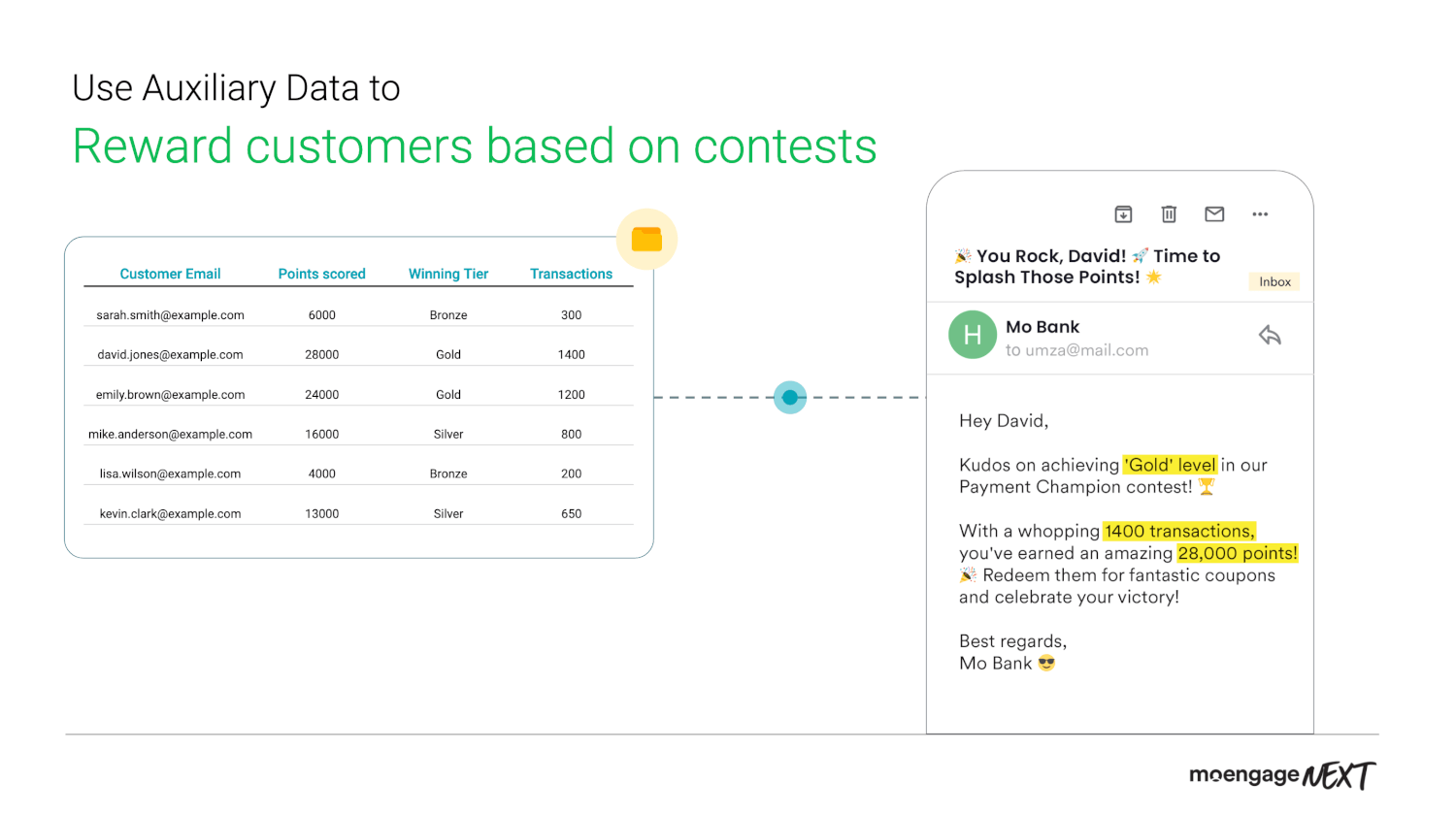
An E-commerce brand can upload tailored coupon codes for customers using Auxiliary Data to trigger promotional discount campaigns
After an in-store feedback survey, a Retail store can upload the survey responses for a short time. They use this data to send personalized ‘thank you’ messages and tailored offers to visitors based on their feedback
An E-commerce brand using legacy systems would like to upload campaign-specific customer segment data received from the central data team to trigger a winter sale campaign without complex data integrations.
Banking and Fintech brands
A bank triggering monthly credit card statements can upload the last 4 digits of the credit card and the amount due through a file using Auxiliary Data to trigger payment reminder emails.
A Fintech brand frequently updates its monthly credit card promotions and needs to include the latest offers in its email campaigns, which engage all customers. They can use Auxiliary Data, allowing marketers to upload this information easily.
A bank with centralized data management and multiple regional subsidiaries shares regional customer segments with local teams for personalized communications, ensuring regional privacy. Local teams can utilize Auxiliary Data to upload this data to drive engagement.
Media & Entertainment (OTT) brands
A music streaming platform triggering weekly top music recommendations for each genre can automatically automate these campaigns and upload content easily.
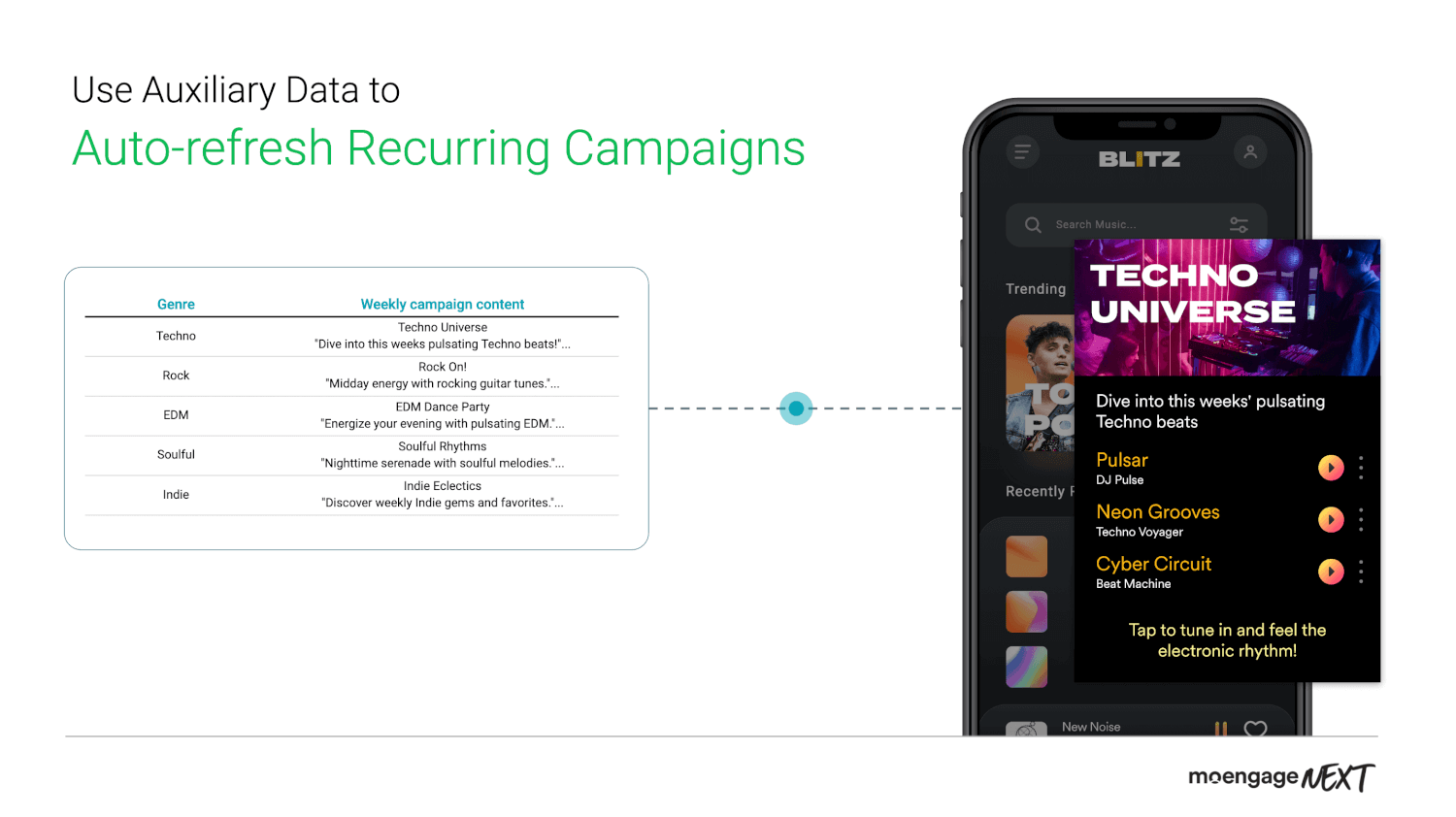
After conducting a viewer satisfaction survey, a video streaming platform can upload survey responses using Auxiliary Data. Using this data (which is short-lived and doesn’t need to be stored permanently), they can send personalized messages and offers exclusively to customers who gave low satisfaction scores.
A video platform can run a streaming contest where viewers accumulate points for watching shows. With Auxiliary Data, the platform can upload participant details and points for a short period. This helps congratulate winners, send personalized offers, and distribute prizes effectively.
A music streaming platform hosting offline events can upload registrant data via Auxiliary Data to personalize engagement and offer discounted subscription packages.
Conclusion and Next Steps
Auxiliary Data by MoEngage is built for marketers, analysts, and product managers who wish to utilize supplemental data to optimize engagement efforts. This additional data can be uploaded and used to personalize campaigns with hyper-relevant messaging.
Legacy Customer Engagement platforms often rely on traditional ‘working with files’ methods and lack contemporary capabilities like APIs, cloud ingestion, and flexible data storage. MoEngage, on the other hand, provides an end-to-end Data Management solution that combines the benefits of legacy systems with modern data handling capabilities – the best of both worlds!
MoEngage’s streamlined process of supplementary data ingestion prevents data clutter and complexities, ensuring efficient data management. It also provides the flexibility to add supplemental information without affecting permanent data and automatically deleting data that is meant to be short-lived.
If you’re an existing MoEngage customer and want to get started with Auxiliary Data, contact your favorite account manager now! If you’re new to MoEngage, you can request a demo and speak to our product experts here.








